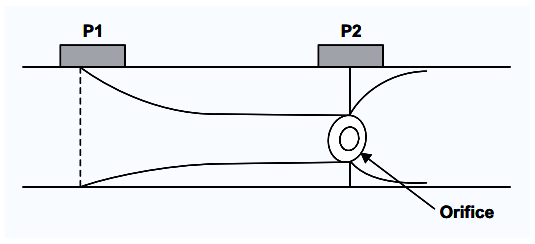This meter operates based on Bernoulli’s principle. It measures the differential-pressure drop across a constriction in the flow’s path to infer the flow velocity.
Common types of differential-pressure flow meters are the orifice, the pitot tube, and the venturi tube. An orifice flow meter (below Figure) is used to create a constriction in the flow path.
Differential-pressure flow meter

As the fluid flows through the hole in the orifice plate, in accordance with the law of conservation of mass, the velocity of the fluid that leaves the orifice is more than the velocity of the fluid as it approaches the orifice.
By Bernoulli’s principle, this means that the pressure on the inlet side is higher than the pressure on the outlet side.
Measuring this differential pressure gives a direct measure of the flow velocity from which the volumetric flow can easily be calculated.
System considerations for differential-pressure flow meters
• Robust and mature technology with easy maintenance (no moving parts)
• Suitable for turbulent flow
• Poor accuracy for low-flow measurements
• Uses extractive flow-measurement technique, so there is always a permanent pressure loss that must be overcome with extra pumping energy
• Requires strict placement of pipe fittings, elbows, and bends for downstream and upstream constriction taps.